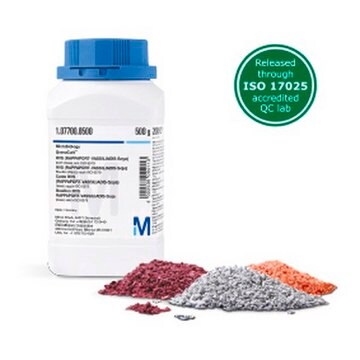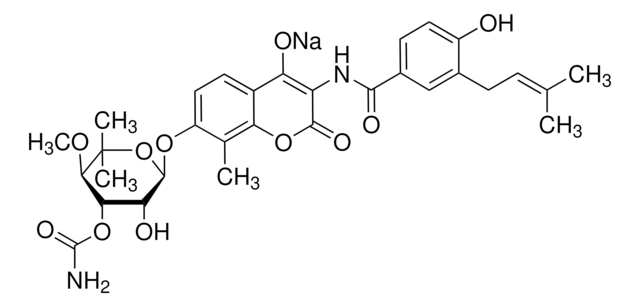1.05878
GranuCult® MULLER-KAUFFMANN Tetrathionate Novobiocin broth (base)
according to ISO 6579, selective for Salmonella spp.
Synonym(s):
MKTT Novobiocin Supplement, MKTTn broth, Novobiocin Selective Supplement
About This Item
Recommended Products
Agency
ISO 11133
according to ISO 6579
Quality Level
sterility
non-sterile
form
granular
manufacturer/tradename
GranuCult® prime
technique(s)
microbiological culture: suitable
application(s)
food and beverages
microbiology
storage temp.
15-25°C
suitability
selective for Salmonella spp.
Related Categories
General description
Application
Analysis Note
Appearance (colour): green
pH-value (25 °C): 7.8 - 8.2
Growth promotion test in accordance with the current version of DIN EN ISO 11133.
Mixed inoculum of Salmonella, E.coli and P.aeruginosa
Additionaly monoculture of E.coli and E.faecalis
Confirmation on XLD agar resp. Tryptic soy agar
Inoculum on reference medium (Salmonella typhimurium ATCC 14028 (WDCM 00031)): ≤ 100
Inoculum on reference medium (Salmonella enteritidis ATCC 13076 (WDCM 00030)): ≤ 100
Inoculum on reference medium (Pseudomonas aeruginosa ATCC 27853 (WDCM 00025)): ≥ 1000
Inoculum on reference medium (Escherichia coli ATCC 25922 (WDCM 00013)): ≥ 1000
Inoculum on reference medium (Escherichia coli ATCC 8739 (WDCM 00012)): ≥ 1000
Inoculum on reference medium (Enterococcus faecalis ATCC 29212 (WDCM 00087)): ≥ 1000
Inoculum on reference medium (Enterococcus faecalis ATCC 19433 (WDCM 00009)): ≥ 1000
Growth on XLD agar (Salmonella typhimurium ATCC 14028 (WDCM 00031)): >10 colonies
Growth on XLD agar (Salmonella enteritidis ATCC 13076 (WDCM 00030)): >10 colonies
Growth on Tryptic soy agar (Escherichia coli ATCC 25922 (WDCM 00013)): <100 colonies
Growth on Tryptic soy agar (Escherichia coli ATCC 8739 (WDCM 00012)): <100 colonies
Growth on Tryptic soy agar (Enterococcus faecalis ATCC 29212 (WDCM 00087)): <10 colonies
Growth on Tryptic soy agar (Enterococcus faecalis ATCC 19433 (WDCM 00009)): <10 colonies
Incubation:
MKTTn broth: 24 ± 3 hours at 37 ± 1 °C aerobic
Confirmation on XLD agar resp. Tryptic Soy Agar: 24 ± 3 hours at 37 ± 1 °C aerobic
Footnote
The designations basic, plus, or prime are added to indicate the quality control level, from basic quality control to standard QC plus to prime for full regulatory compliance.
Legal Information
Storage Class Code
13 - Non Combustible Solids
WGK
WGK 3
Flash Point(F)
Not applicable
Flash Point(C)
Not applicable
Certificates of Analysis (COA)
Search for Certificates of Analysis (COA) by entering the products Lot/Batch Number. Lot and Batch Numbers can be found on a product’s label following the words ‘Lot’ or ‘Batch’.
Already Own This Product?
Find documentation for the products that you have recently purchased in the Document Library.
Customers Also Viewed
Articles
Salmonella pass through the entire food chain from animal feed, primary production, and into households or food-service establishments.
Protocols
Specifies a horizontal method for the detection of Salmonella spp. in the food production chain.
Our team of scientists has experience in all areas of research including Life Science, Material Science, Chemical Synthesis, Chromatography, Analytical and many others.
Contact Technical Service
